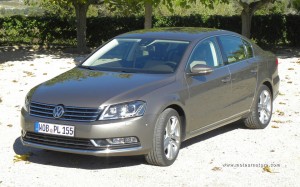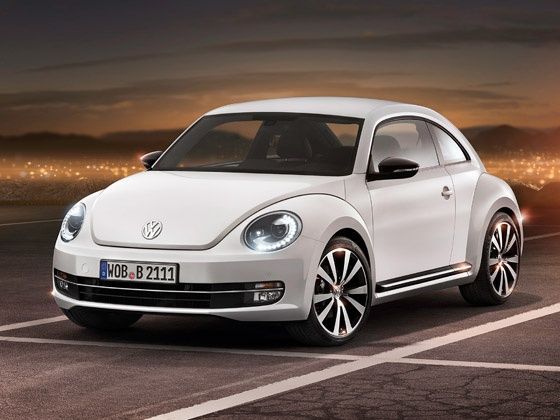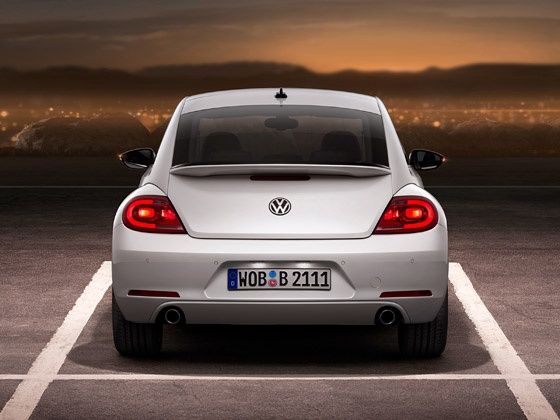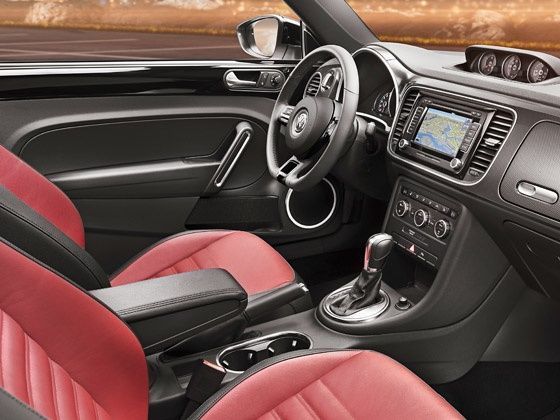2011 Volkswagen Passat 118TSI sedan, 1.8-litre petrol, seven-speed DSG – $38,990
2011 Volkswagen Passat 125TDI wagon, 2.0-litre diesel, six-speed DSG – $45,990

Those familiar with the Super Bowl commercial will remember the new 2011 Volkswagen Passat as the ‘Baby Darth Vader car’.
But the refreshed premium mid-sizer from Germany is more about science than science fiction, with a number of new features making it safer, better equipped and more efficient than ever.

The last Passat carved out a 3.2 percent share of the medium vehicle segment in 2010, with 2603 sales across Australia. Like many Volkswagen products, it occupies that slightly awkward space in the market in-between price points, and consequently has been outsold by most of those around it.
The Honda Accord Euro, Hyundai i45, Mazda6 and Toyota Camry all start at around $30,000 and top out below $45,000, while at the other end of the spectrum, the Audi A4, BMW 3 Series, Lexus IS and Mercedes-Benz C-Class all get started around $55,000.

The new Passat sits in the middle of the bargain-hunters and the badge snobs, with prices ranging from $38,990 to $57,990.
If those prices sound familiar, there’s a good reason: Volkswagen Australia has maintained the prices of the old model. The diesel engine still demands a $5000 premium over the base petrol, while the step up from the four-cylinder petrol to the V6 is a considerable $17,000. Wagon variants cost $2000 more than their equivalent sedans.

The value equation of the V6 is now much more tempting, however. Although Volkswagen has dropped the R36 model from the line-up, the range-topping V6 FSI Highline inherits the engine from the outgoing R36, resulting in a significant boost in power and torque from 184kW/330Nm to 220kW/350Nm. Power and torque figures for the other engines remain unchanged.
Despite this, every model is greener than before, with the standard fitment of brake energy recuperation the major factor behind the improvements.

The 118kW/250Nm turbocharged four-cylinder 118TSI petrol model now uses 7.2 litres/100km on the combined cycle (7.5 for the wagon) – down from 7.7 and 7.8 respectively. Emissions are also tidier at 168 and 176g/km CO2.
At 9.7 litres/100km (9.5 wagon), the V6 FSI Highline model is more efficient than both the old V6 Highline and the R36, which ranged between 10.0 and 10.7 litres/100km combined.

The pick of the bunch for fuel-conscious shoppers is the TDI125 Highline. Powered by a 2.0-litre diesel engine with 125kW and 350Nm, both the sedan and wagon variants use just 5.7 litres/100km.
The diesel Passat is now equipped with stop-start technology, which shuts down the engine when stopped in traffic and restarts it when you take your foot off the brake.

The diesel’s shutdown and restart process is a little harsher than comparative petrol systems. Some find it a little unnerving and slow to react on take-off, and those people can deactivate it with a button near the gearstick.
The diesel model itself is a brilliant all-rounder. It has more power than the TSI, the same torque as the V6 FSI and smashes them both for efficiency. The torque doesn’t come on in a massive surge but rather in a more comfortable, progressive fashion. There is some slight turbo lag when you stamp on the throttle, but drivers familiar with diesel cars won’t be disappointed, and it’s unlikely to be the deal-breaker for first-time diesel shoppers either.

Both Highline models are equipped with a six-speed DSG (direct shift gearbox) while the 118TSI gets a seven-speed DSG. The six-speed didn’t miss a beat on our drive, while the seven-speed only hesitated once when shifting from first gear to second under solid acceleration. The DSG system was criticised early in its life for being indecisive, but avoiding the new Passat simply because of the transmission would be a big mistake.
Volkswagen has also fitted a selectable Auto Hold function to stop the manual-style rolling that some automatic drivers find off-putting in dual-clutch vehicles.

With many European vehicles today, the diesel model has become the standout in the range, but the 118TSI is a true alternative with plenty of punch and better than average fuel consumption. It accelerates from 0-100km/h just 0.1 seconds faster than the 125TDI – 8.5 seconds sedan, 8.7 wagon – but feels livelier and sounds sportier. Putting it into ‘S’ mode, you’ll find it hard to suppress a smile as the car revs 1000rpm more than you’re used to, making you feel like a bit of a racer without changing your driving style.
The all-wheel drive V6 model has loads of family sports car potential. The sedan accelerates from 0-100km/h in just 5.5 seconds, making it just four-tenths slower than the dual-clutch Audi S4, which is more than double the price.

The brake pedal feel isn’t typical touchy Volkswagen and is easier to drive smoothly. Like other new models in Volkswagen’s range, the Passat’s brakes are tremendously progressive and confidence inspiring.
The ride is comfortable on average surfaces and you only start to get tossed around on coarse and bumpy sections of road. The steering has a light feel and keeps you busy in low-speed manoeuvres, but is extremely obedient and will go where you point it. Road noise is insignificant on freeways and only started to nag on C-grade roads around Victoria’s Mornington Peninsula. There was next to no wind noise from the side mirrors or A-pillars.

The dimensions of the new Passat are almost identical to the old model, with a height increase of 20mm the most significant change.
The Passat looks somewhat skinny on the road and this impacts on the cabin width. That said, you certainly don’t feel cramped with four occupants, and taller adults won’t be troubled riding in the back.

The boot is cavernous. The sedan offers 565 litres (541 litres for the all-wheel drive V6), while the wagon provides 603 litres (588 litres) and 1731 litres (1716 litres) with the seats folded down. The sedan’s boot is not especially tall from floor to ceiling, although with a standard full-sized alloy spare it’s hard to be too critical.
Comfort levels are great. The base model now gets leather upholstery, while the Highline models get a classier Nappa finish. Standard cabin features include tinted windows, dual-zone climate control, 6.5-inch colour touchscreen with six-stack in-dash CD changer, SD card slot, auxiliary jack, Bluetooth phone and audio streaming, iPod/USB/mini USB connectivity and eight speakers.

The interior is classic Volkswagen – clean and effective. There are a few more hard plastic surfaces than you would expect, although they don’t really take away from the overall quality feel of the cabin.
Safety is another strong point for the Passat, with eight airbags standard (dual front, side, curtain and rear side). Fatigue Detection is another new feature that analyses your driving style and gives warnings when your driving patterns show signs of tiredness.
The exterior is conservative, although the medium segment is hardly overflowing with flamboyant designs. All models get plenty of chrome in the grille, window surrounds and lower body panels as well as daytime driving lights (LEDs optional). The 118TSI and 125TDI sit on 17-inch alloys while the V6 gets 18s.
Over the 118TSI, the 125TDI Highline adds front fog lights, brushed aluminium interior inserts, chrome highlights and stainless steel scuff plates.

The V6 FSI Highline scores a vehicle alarm, left and right dual exhaust pipes, Adaptive Chassis Control, folding exterior mirrors and 12-way adjustable front seats with three driver memory settings.
Adaptive Cruise Control with Front Assist and City Electric Brake is both a mouthful and a $2000 option. The adaptive cruise setting allows you to maintain your favoured distance from the vehicle in front, while Front Assist and City EB decrease your chance of a nose-to-tail crash.
The second-generation Park Assist system can now perform reverse perpendicular parks as well as reverse parallels, can locate spaces at greater vehicle speeds and can help you in and out of tighter spots. It’s still far from fail-safe, however, with one car on the launch day making contact with another when performing a 90-degree park. When combined with satellite navigation and a rear-view camera, Park Assist 2 is a $3600 option ($1300 on its own).
They’re expensive options. If you purchase a 118TSI sedan and add sat-nav and metallic paint ($700), it will be $42,690 before on-roads, which will push it beyond $45,000. Throw in Adaptive Cruise Control and Park Assist, and your well-optioned base model will be closer to $50,000 on the road.

The challenge for Volkswagen Australia will be convincing people to hit the middle ground between a Camry and a C-Class. If you’re in the market for a classy, composed and more than competent performer that will handle almost anything a family can throw at it while sipping less fuel than its similarly-priced competitors, the 2011 Volkswagen Passat is certainly worth a test drive.
2011 Volkswagen Passat manufacturer’s list prices:
- 118TSI sedan – $38,990
- 118TSI wagon – $40,990
- 125TDI Highline sedan – $43,990
- 125TDI Highline wagon – $45,990
- V6 FSI Highline sedan – $55,990
- V6 FSI Highline wagon – $57,990













































